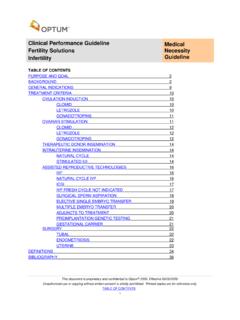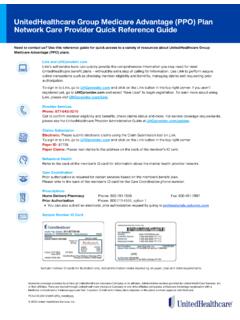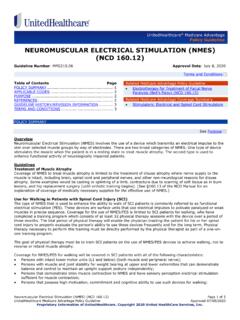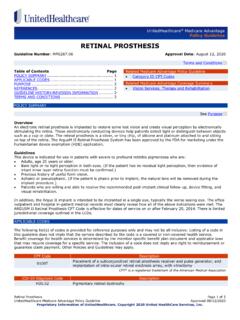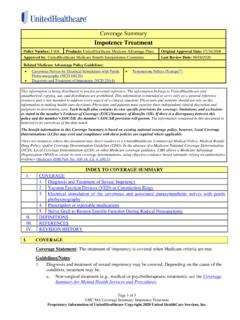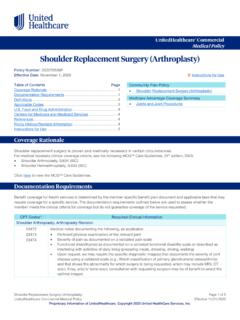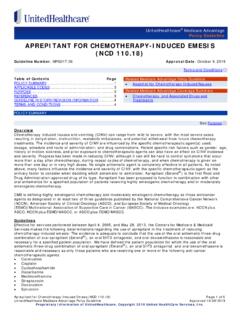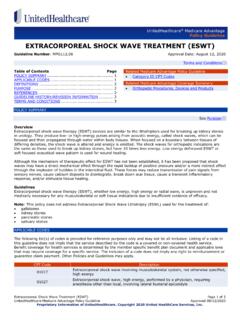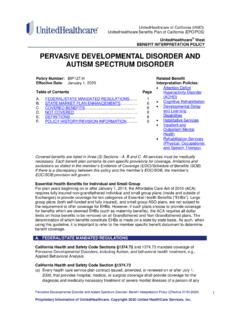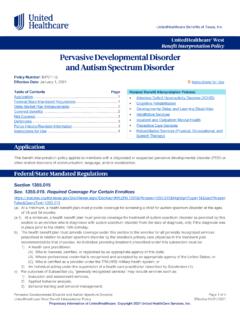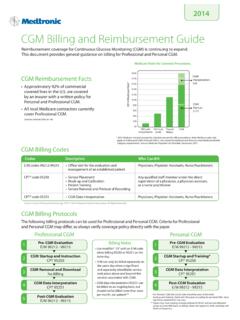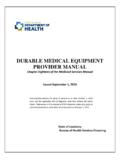Transcription of THERAPEUTIC CONTINUOUS BLOOD GLUCOSE MONITORS
1 THERAPEUTIC CONTINUOUS BLOOD GLUCOSE MONITORS Page 1 of 22 UnitedHealthcare Medicare Advantage Policy Guideline Approved 04/08/2020 Proprietary Information of UnitedHealthcare. Copyright 2020 United HealthCare Services, Inc. THERAPEUTIC CONTINUOUS BLOOD GLUCOSE MONITORS Guideline Number: Approval Date: April 8, 2020 Table of Contents Page POLICY SUMMARY .. 1 APPLICABLE CODES .. 3 QUESTIONS AND ANSWERS .. 19 PURPOSE .. 19 REFERENCES .. 19 GUIDELINE HISTORY/REVISION INFORMATION .. 20 TERMS AND CONDITIONS .. 21 POLICY SUMMARY Overview On January 12, 2017, the Centers for Medicare & Medicaid Services (CMS) issued CMS Ruling 1682R addressing non-adjunctive THERAPEUTIC CONTINUOUS GLUCOSE monitoring (CGM) systems. A THERAPEUTIC CGM falls within the scope of the Medicare benefit category for DME. A THERAPEUTIC CGM is used as a replacement for fingerstick BLOOD GLUCOSE testing for diabetes treatment decisions, , non-adjunctive use.
2 Non- THERAPEUTIC CGM are devices used to complement (not replace) and used as an adjunct to BLOOD GLUCOSE monitor (BGM) testing ( , primary THERAPEUTIC decisions regarding diabetes treatment that are made with a standard home BGM, not a CGM). Non- THERAPEUTIC CGMs are non-covered (No Medicare benefit) as they do not meet Medicare criteria outlined in the CMS Ruling 1682R (See Classification of THERAPEUTIC CONTINUOUS GLUCOSE MONITORS as DME under Medicare Part B, CMS Ruling CMS-1682-R, dated January 12, 2017, CMS Website). Certain CGM devices consist of three components: a GLUCOSE sensor, a transmitter, and a receiver. The GLUCOSE sensor continuously measures GLUCOSE values (for example, every 5 minutes) in the interstitial fluid, the fluid around the cells (in contrast to BLOOD GLUCOSE MONITORS , which measure GLUCOSE values using fingertip BLOOD samples). The sensor is a small flexible metal probe or wire that is inserted just below the skin and has a coating that prevents the body's immune system from detecting and attacking the foreign probe.
3 Once the coating wears off in 6 or 7 days, the sensor must be replaced for safety reasons. The GLUCOSE sensor generates a small electrical signal in response to the amount of sugar that is present (interstitial GLUCOSE ). This electrical signal is converted into a GLUCOSE reading that is then sent by tiny electrodes to the transmitter. The transmitter sends the measurements wirelessly to a dedicated receiver (or type of monitor ) and/or compatible mobile device (smart phone, tablet, etc.) for display to a user. The receiver displays the GLUCOSE measurements in the form of a graph so that patients can visualize how their GLUCOSE measurements are trending up or down. For CGM products that are used in the home and approved by the Food and Drug Administration (FDA) for use in place of a BLOOD GLUCOSE monitor for making diabetes treatment decisions, these THERAPEUTIC CGMs are primarily and customarily used to serve a medical purpose because they are used by Medicare members with diabetes who must measure their GLUCOSE levels frequently and check trends in their GLUCOSE measurements for the purpose of adjusting their diet and insulin in the treatment of their diabetes.
4 A receiver (or type of monitor ) for a THERAPEUTIC CGM that has an expected life of at least 3 years and is the component performing the medically necessary function of accurately monitoring the trends of the patient s BLOOD GLUCOSE levels so that he or she can make necessary diabetes treatment decisions meets the 3-year MLR (minimum lifetime requirements). The system as a whole replaces the BLOOD GLUCOSE monitor for GLUCOSE monitoring purposes. As a result, the durable receiver for a THERAPEUTIC CGM is considered DME. For THERAPEUTIC CGMs, the GLUCOSE sensors and transmitters are considered essential accessories necessary for the Related Medicare Advantage Policy Guidelines Home BLOOD GLUCOSE MONITORS (NCD ) Durable Medical Equipment Reference List (NCD ) Related Medicare Advantage Coverage Summaries Diabetes Management, Equipment and Supplies Durable Medical Equipment, Prosthetics, Corrective Appliances/Orthotics and Medical Supplies Durable Medical Equipment (DME), Prosthetics, Corrective Appliances/Orthotics (Non-Foot Orthotics) and Medical Supplies Grid UnitedHealthcare Medicare Advantage Policy Guideline Terms and Conditions See Purpose THERAPEUTIC CONTINUOUS BLOOD GLUCOSE MONITORS Page 2 of 22 UnitedHealthcare Medicare Advantage Policy Guideline Approved 04/08/2020 Proprietary Information of UnitedHealthcare.
5 Copyright 2020 United HealthCare Services, Inc. effective use of the THERAPEUTIC CGM, and replacement of the GLUCOSE sensors and transmitters are considered replacements of essential accessories necessary for the effective use of DME. CONTINUOUS GLUCOSE monitoring systems are considered THERAPEUTIC CGMs that meet the definition of durable medical equipment at section 1861(n) of the Act and 42 CFR if the equipment: Is approved by the FDA for use in place of a BLOOD GLUCOSE monitor for making diabetes treatment decisions (for example, changes in diet and insulin dosage); Generally is not useful to the individual in the absence of an illness or injury; Is appropriate for use in the home; and Includes a durable component (a component that CMS determines can withstand repeated use and has an expected lifetime of at least 3 years) that is capable of displaying the trending of the CONTINUOUS GLUCOSE measurements.
6 Patient Coverage Criteria An FDA-approved THERAPEUTIC CGM may be covered when all of the following six (6) bulleted criteria are met: The member has diabetes mellitus; and, The member has been using a home BLOOD GLUCOSE monitor (BGM) and performing frequent (four or more times a day) BGM testing; and, The member is insulin-treated with multiple (three or more) daily injections of insulin or a Medicare-covered CONTINUOUS subcutaneous insulin infusion (CSII) pump; and, The member s insulin treatment regimen requires frequent adjustment by the member on the basis of BGM or CGM testing results. Within six (6) months prior to ordering the CGM, the treating practitioner has an in-person visit with the member to evaluate his or her diabetes control and determined that criteria (bullets 1-4 under Patient Coverage Criteria) above are met; and, Every six (6) months following the initial prescription of the CGM, the treating practitioner has an in-person visit with the member to assess adherence to their CGM regimen and diabetes treatment plan.
7 If any of coverage criteria (1-6) are not met, the CGM and related supply allowance will be denied as not reasonable and necessary. Guidelines Effective for claims with dates of service on or after January 12, 2017, Medicare covers THERAPEUTIC CGM devices under the DME benefit. CGM devices covered by Medicare are defined in CMS Ruling 1682R as THERAPEUTIC CGM. CGM devices that do not meet the definition of a THERAPEUTIC CGM as defined in CMS Ruling 1682R will be denied as non-covered (no benefit). DME The DME component for a CGM system is the receiver. The receiver must be billed using the following code: K0554-Receiver ( monitor ), dedicated, for use with THERAPEUTIC GLUCOSE CONTINUOUS monitor system Smart devices are non-covered by Medicare because they do not meet the definition of DME ( , not primarily medical in nature and are useful in the absence of illness). Claims for smart devices must be billed using code A9270 (non-covered item or service).
8 The Supply Allowance The supply allowance for supplies used with a CGM System encompasses all items necessary for the use of the device and includes, but is not limited to: CGM sensor, CGM transmitter, home BLOOD GLUCOSE monitor and related BGM supplies (test strips, lancets, lancing device, and calibration solutions) and all batteries. The supply allowance must be billed using the following code: K0553-Supply allowance for THERAPEUTIC CONTINUOUS GLUCOSE monitor (CGM), includes all supplies and accessories, 1 month supply = 1 Unit of Service **Note: HCPCS codes E1399, A9999 were effective from 01/12/2017 to 06/30/2017, for a DME receiver/ monitor (K0554) and supply allowance (K0553). For claims with dates of service on or after July 1, 2017, a THERAPEUTIC CGM must be billed with code K0554 and code K0553 for the supply allowance. Coverage of a CGM system supply allowance (K0553) is available for those THERAPEUTIC CGM systems where the member uses a receiver classified as DME to display GLUCOSE data.
9 In addition, Medicare coverage is available for a CGM system supply allowance if a non-DME device (watch, smartphone, tablet, laptop computer, etc.) is used in conjunction with the durable CGM receiver (K0554). The following are examples of this provision: THERAPEUTIC CONTINUOUS BLOOD GLUCOSE MONITORS Page 3 of 22 UnitedHealthcare Medicare Advantage Policy Guideline Approved 04/08/2020 Proprietary Information of UnitedHealthcare. Copyright 2020 United HealthCare Services, Inc. Medicare coverage of a CGM supply allowance is available where a member uses a durable CGM receiver to display their GLUCOSE data and also transmits that data to a caregiver through a smart phone or other non-DME receiver. Medicare coverage of a CGM system supply allowance is available where a member uses a durable CGM receiver on some days to review their GLUCOSE data but may also use a non-DME device on other days.
10 When a THERAPEUTIC CGM (code K0554) is covered, the related supply allowance (code K0553) is also covered. If a member never uses a DME receiver for a THERAPEUTIC CGM, the supply allowance is not covered by Medicare. Miscellaneous Coding Information Durable medical equipment, prosthetics, orthotics and supplies (DMEPOS) suppliers who provide an FDA-approved CGM System are reminded of the following Medicare coverage policies: The supply allowance (code K0553) is billed as 1 Unit of Service (UOS) per 30 days. Only one (1) UOS of code K0553 may be billed to the DME MACs at a time. Billing more than 1 UOS per 30 days of code K0553 will be denied as not reasonable and necessary. THERAPEUTIC CGM devices replace a standard home BLOOD GLUCOSE monitor (HCPCS codes E0607, E2100, E2101) and related supplies (HCPCS codes A4233-A4236, A4244-A4247, A4250, A4253, A4255-A4259, see NCD Home BLOOD GLUCOSE MONITORS ).
